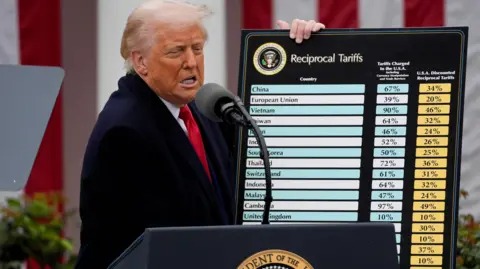The Donald Trump administration has imposed sweeping tariffs, using the International Emergency Economic Powers Act (IEEPA) as the legal basis. However, the Supreme Court of the United States appeared skeptical during recent hearings of whether IEEPA legally allows such broad tariff action Tariff News. The Washington Post+4CBS News+4ABC News+4
Key points:
-
The Court questioned whether setting tariffs is something only Congress can do (rather than via emergency powers). AP News+1
-
The administration argues the purpose is not revenue‑raising but regulating imports to protect domestic industry. The Washington Post
-
If ruled unconstitutional, there could be refunds, upheaval in trade policy, and increased uncertainty. Reuters+1
Global trade & sectoral impact
-
According to the Organisation for Economic Co‑operation and Development (OECD), higher tariffs will slow global economic growth, raise inflation and reduce real incomes. mint
-
Many countries are feeling pressure: e.g., India’s seafood exporters face US tariffs of ~58 % in key segments, hurting competitiveness. The Times of India
-
Shipping & logistics players are cautious: For example, Maersk cited China as a stabilising force amid the turmoil, but noted the broader trade uncertainty. Financial Times
Developments in and around Pakistan
Given your location in Pakistan, these developments matter:
-
The government has committed to reducing its average applied tariffs by ~43 % over five years under an agreement with the International Monetary Fund (IMF). Business Standard+1
-
At the same time, Pakistan’s exports to the US face risk: A study estimated that if the US increases tariffs on Pakistani goods, exports could drop 20‑25% (losses of US $1.1‑1.4 billion annually). Profit by Pakistan Today
-
Pakistan also stated it wants to boost imports from the US and ease non‑tariff barriers as a way to mitigate risk. The Express Tribune
Why this matters
For consumers & businesses
-
Tariffs raise the cost of imported goods—consumers ultimately pay more, and businesses importing raw materials or components face higher input costs. For example, OECD modelling shows real incomes falling in the U.S. after big tariff hikes. mint
-
Exporters in countries like Pakistan face reduced competitiveness when key markets impose higher duties or when there’s retaliation.
-
Businesses may need to rethink where they manufacture, supply‐chain hubs and sourcing strategies: for example, one company is shifting production out of China in response. The Australian
For national economies and trade policy
-
Tariff wars increase uncertainty in global trade, making long‐term investments riskier.
-
Countries that are heavily export‑dependent (like Pakistan) must pay attention to external tariff regimes and ensure trade diversification.
-
Domestic policy choices matter: Pakistan’s tariff‑cut commitments to the IMF indicate a shift in strategy—less protectionism, more openness. But that also means local industries need to become more competitive.
For geopolitics & global trade architecture
-
The U.S. legal challenge raises questions about how trade policy is made (executive vs legislative power).
-
If the U.S. imposes sweeping tariffs, other countries may respond in kind or shift trade alliances.
-
Multilateral trade rules (e.g., through the World Trade Organization) are under pressure as unilateral tariffs gain traction. ICC – Näringslivets världsorganisation+1
What to watch next
Here are some key indicators and developments to keep an eye on:
-
Supreme Court decision on the U.S. tariffs case: The outcome will shape whether the tariffs remain, are rescinded, or need refunds.
-
Trade responses: Which countries retaliate, negotiation outcomes, and new trade deals.
-
Impact on Pakistan’s exports: Whether tariff pressures force shifts in market focus (e.g., beyond the US) or product value‐addition strategies (as seen in India’s seafood exports scenario).
-
Supply‑chain shifts: Companies relocating manufacturing, sourcing from alternate countries, or redesigning products to avoid tariffs.
-
Domestic tariff reforms in Pakistan: The pace and implementation of tariff reduction, how industries adapt, and how foreign investment reacts.
-
Global economic growth & inflation: Tariff policy is feeding into macroeconomic variables like inflation, growth, trade volumes.
Implications & recommendations for Pakistan
Given everything above, here are some tailored thoughts for Pakistan:
-
Diversify export markets: Given the risk of tariffs in major markets like the U.S., Pakistani exporters should boost presence in other regions (Asia, Africa, Middle East) and reduce reliance on a single destination.
-
Focus on value addition: Rather than just exporting raw or low‐margin goods, increasing the value chain (e.g., processed seafood rather than raw; finished apparel rather than fabrics) helps buffer against tariff shocks.
-
Strengthen competitiveness: As protection via tariffs comes under pressure (both globally and domestically via Pakistan’s reforms), local industries must invest in productivity, quality, innovation.
-
Monitor trade policy globally: Stay alert to changes in trade rules, new tariffs, and bilateral negotiation outcomes, as these may impact Pakistan’s trade landscape.
-
Leverage domestic tariff reform: With Pakistan committing to reducing tariffs and regulatory duties (e.g., new National Tariff Policy) Mettis Global+1, there is an opportunity to attract investment and integrate more fully into global supply chains—provided the infrastructure and policy environment support it.
-
Mitigate consumer/inflation risk: Higher import tariffs somewhere else may raise global input costs; Pakistan should ensure critical imports (components, raw materials) remain affordable or find alternatives.
Conclusion
Tariff policy is once again at the centre of global economic strategy. What may look like an isolated policy move in one country (e.g., the U.S.) can ripple out globally—affecting trade flows, supply chains, competitiveness, inflation and growth.
